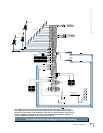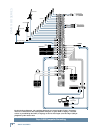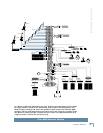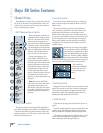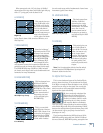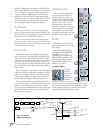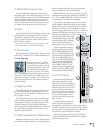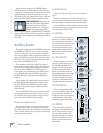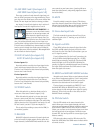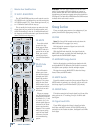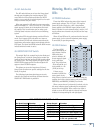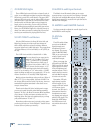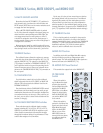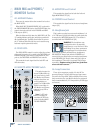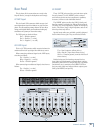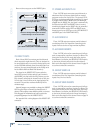
15
Owner’s Manual
Owner’s Manual
28. AUX SEND 1 and 2 (Aux Inputs 1-4)
AUX SEND 5 and 6 (Aux Inputs 5-8)
These tap a portion of each channel’s signal out to ei-
ther an effects processor or for stage monitoring. These
go to the same Aux Send buses as the mono channel Aux
Sends. The Aux Input Aux Sends are always pre-fader.
Aux Inputs 1-4 send their signals to Aux 1 and Aux 2.
Aux Inputs 5-8 send their signals to Aux 5 and 6.
FEEDBACK LOOP WARNING: It is
common to use an Aux Send to route
signals to an external processor, and
then return the signal from the pro-
cessor via the Aux Inputs.
Since the
Aux Inputs on the Onyx 80 Series have Aux Sends of their
own, you could accidentally route the Aux Input to an
Aux Send that is being returned via that same Aux Input.
This will cause a feedback loop, characterized by a LOUD
howl or screech through the sound system, followed by
howls of discontent from the audience.
Be careful with
the Aux Sends on the Aux Inputs!
29. AUX 3-4 Switch (Aux Inputs 1-4)
AUX 7-8 Switch (Aux Inputs 5-8)
For Aux Inputs 1-4:
Press this switch to send the Aux Input signal to the
Aux 3 and 4 buses instead of the Aux 1 and 2 buses.
The Aux 1 and 2 knobs for that channel strip suddenly
become Aux 3 and 4 knobs!
For Aux Inputs 5-8:
Press this switch to send the Aux Input signal to the
Aux 7 and 8 buses instead of the Aux 5 and 6 buses.
The Aux 5 and 6 knobs for that channel strip suddenly
become Aux 7 and 8 knobs!
30. STEREO Switch
When this switch is up, both Aux Sends are fed a
mono sum of the stereo channel’s signal (L+R).
When this switch is pushed in, the two Aux sends
become a stereo send, with Aux 1 sending the right
signal and Aux 2 sending the left signal. The same thing
applies when Aux 3-4 is selected for Aux Inputs 1-4, and
for Aux 5 and 6 (and Aux 7-8) for Aux Inputs 5-8.
This is useful for providing a stereo mix for IEM (in-
ear monitor) systems.
31. BALANCE
BALANCE adjusts the amount of channel signal sent
to the left versus the right outputs. On the stereo Aux
Input channels, the BALANCE knob works like the bal-
ance control on your home stereo (panning left turns
down the right channel, and panning right turns down
the left channel).
32. MUTE
Press this switch to mute the channel. This discon-
nects the channel’s signal from all the Groups, the Main
Mix, and Aux Send buses. You can still solo the channel
in PFL mode when the MUTE switch is pushed in.
33. Stereo Aux Input Fader
The fader controls the stereo channel’s level, from
off to unity gain at the “U” marking, on up to 10 dB of
additional gain.
34. Signal Level LEDs
These LEDs indicate the channel’s signal level after
the GAIN and EQ controls, but just prior to the chan-
nel’s
fader. So even if the fader is turned down, you can
see if a signal is present.
If you’ve followed the “Set the Levels”
procedure, the
–20 and 0 LEDs should light frequently, the +10 LED
should light occasionally, and the OL (Overload) LED
should not light at all. If the OL LED is blinking fre-
quently, the signal is probably distorted from overdriving
the input. Either turn down the GAIN control or turn
down the signal at its source.
35. GROUP and MAIN MIX ASSIGN Switches
Alongside each channel fader are two buttons referred
to as channel assignment switches. Used in conjunction
with the channel’s BALANCE knob, they are used to
determine the destination of the channel’s signal.
The Aux Inputs are assignable to GROUPS 7-8 and
the MAIN MIX. With the BALANCE knob [31] at the
center detent, the left and right stereo signal is equally
balanced. To feed only one side or the other, turn the
BALANCE knob accordingly.
36. PFL Solo Switch
Like the PFL switch on the mono channels, this
switch allows you to hear signals through your head-
phones or monitor outputs without having to route them
to the MAIN or GROUP mixes. Since this is Pre-Fader
Listen, you can listen to the stereo Aux Input even when
the Aux Input fader is turned down. Unlike the mono
channel PFL, the Aux Input PFL is a stereo signal (post-
balance control).
PFL solo mode always overides AFL solo mode. The
Rude Solo LEDS below the SOLO meters indicate which
solo mode is active.



